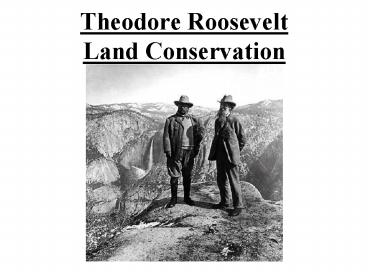Theodore Roosevelt Land Conservation PowerPoint PPT Presentation
Title: Theodore Roosevelt Land Conservation
1
Theodore RooseveltLand Conservation
2
Land Conservation
- The cornerstone to his Domestic Policy.
3
Reasons for Conservation
- Government paid little attention to the nations
natural resources in 1800s. - Private interests bought up the shrinking
wilderness. - Urban growth.
- Population increase.
- Immigration.
4
Industrialization
- Industrial waste dumped on land and in rivers.
- Mining stripped the land.
- Lumber companies over-logging affected flood
control.
5
(No Transcript)
6
Impact of Farming and Cattle Ranchers
- Pioneer farmers clearing forests and plowing the
prairies. - Overgrazing of cattle in the Great Plains.
7
Roosevelt Takes Action
- He alerted Americans that our resource supply was
not endless. - Roosevelt influenced by naturalists John Muir and
Gifford Pinchot.
8
His Accomplishments
- 150 National Forests.
- 51 Federal Bird Reservations.
- 4 National Game Reserves.
- 5 National Parks.
- 18 National Monuments.
- 24 Reclamation Projects.
- 7 Conservation Conferences and Commissions.
9
National Parks
Crater Lake, Oregon
10
Wind Cave, South Dakota
11
Sullys Hill, North Dakota
12
Platt, Oklahoma
13
Mesa Verde, Colorado.
14
- He fought unsuccessfully to make the Grand Canyon
a N.P. - He did protect it by declaring it a National
Monument. - It will become a N.P. in 1919 after Roosevelt was
president.
15
Antiquities Act 1906
- The first law to establish that archeological
sites on public lands are important public
resources. - Obligates federal agencies that manage the public
lands to preserve for present and future
generations the historic, scientific,
commemorative, and cultural values of the
archaeological and historic site and structures
on these lands.
16
continued
- Authorizes the President to protect landmarks,
structures, and objects of historic or scientific
interest by designating them as National
Monuments.
PowerShow.com is a leading presentation sharing website. It has millions of presentations already uploaded and available with 1,000s more being uploaded by its users every day. Whatever your area of interest, here you’ll be able to find and view presentations you’ll love and possibly download. And, best of all, it is completely free and easy to use.
You might even have a presentation you’d like to share with others. If so, just upload it to PowerShow.com. We’ll convert it to an HTML5 slideshow that includes all the media types you’ve already added: audio, video, music, pictures, animations and transition effects. Then you can share it with your target audience as well as PowerShow.com’s millions of monthly visitors. And, again, it’s all free.
About the Developers
PowerShow.com is brought to you by CrystalGraphics, the award-winning developer and market-leading publisher of rich-media enhancement products for presentations. Our product offerings include millions of PowerPoint templates, diagrams, animated 3D characters and more.

